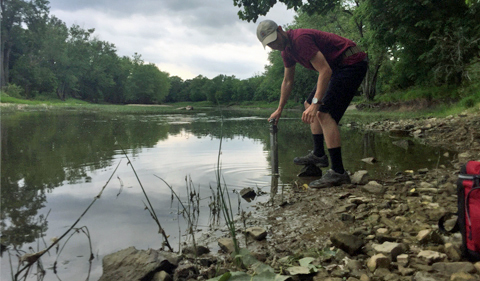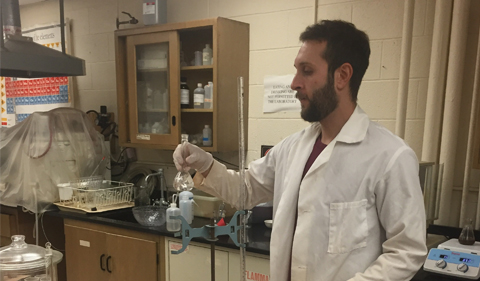
Lucas Howard collects a sediment sample along the Maumee River. Nutrient loads are examined in both the deposited sediment and water samples.
Contamination of the Maumee River due to agricultural activities is a significant problem for the water resources at Lake Erie and cities like Toledo, Ohio. Specifically, harmful algae blooms are a subject of growing concern and study.
Aided by fertilizer runoff, harmful algae blooms can grow rapidly and cover vast areas of fresh and saline water environments. To tackle this problem Geological Sciences second-year master student Lucas Howard M.S. ’19 is working with Dr. Dina López to evaluate the link between nutrient loads, water quality, and algal blooms on Lake Erie.
Harmful algae blooms are considered environmentally hazardous because they deplete the underlying ecosystem of oxygen and sunlight. The aptly named “dead zones” are areas of water that do not have enough dissolved oxygen to support aquatic life. Many of the species of algae that make up harmful algae blooms also are able to produce toxic compounds when their cells degrade.
Howard compared algal blooms on Lake Erie with the red tides on the western coast of Florida. Red tides are caused by dinoflagellate (plankton) blooms and can produce neurotoxins, which devastate marine life, and can become airborne in highly concentrated blooms. Cyanobacteria (blue-green algae) blooms, on the other hand, are common in fresh water environments. Like the red tides, these blooms can produce dead zones and neurotoxins that are harmful to humans and wildlife if ingested.
To tackle this problem, Howard is collecting water and sediment samples along the final 50 mile section of the Maumee River before it discharges into Lake Erie. Howard’s sampling effort comprises a 10-month long monitoring survey of the Maumee River, a large tributary that flows through about 135 miles of land dominated by agricultural use, to understand the seasonal variations of pollutants in this river and its impact on the production of algae blooms that degrade water quality.
Nutrients from fertilizers like phosphorous, nitrate and sulfate are picked up along the flow path of the Maumee and ultimately introduced into the lake. Sediment samples have been collected at these sites and analyzed for the same sites and analyzed for the same compounds. The long-term nature of the sampling will produce a detailed summary of the origins and evolution of nutrient concentrations contributing to Lake Erie’s annual algae blooms during all four seasons.

Howard analysis his water samples in Clippinger Lab
Howard then analyzes his samples for nitrate, phosphate, sulfate, and alkalinity to identify the amount of nutrients and other water quality parameters in the river. With this research, Howard will provide important information about the location of the main sources of pollution and how those sources vary with time. This information can provide insights on the link between farming practices and algal blooms on Lake Erie and can be used to decrease the input of pollutants and improve the water quality of the river.
“I am quite excited to be able to work on such an important environmental issue. It is my sincere hope that the research being done on Lake Erie and its tributaries will lead to more sustainable farming practices; so that we may continue to enjoy all of the benefits from healthy aquatic ecosystems,” Howard said.



















Comments